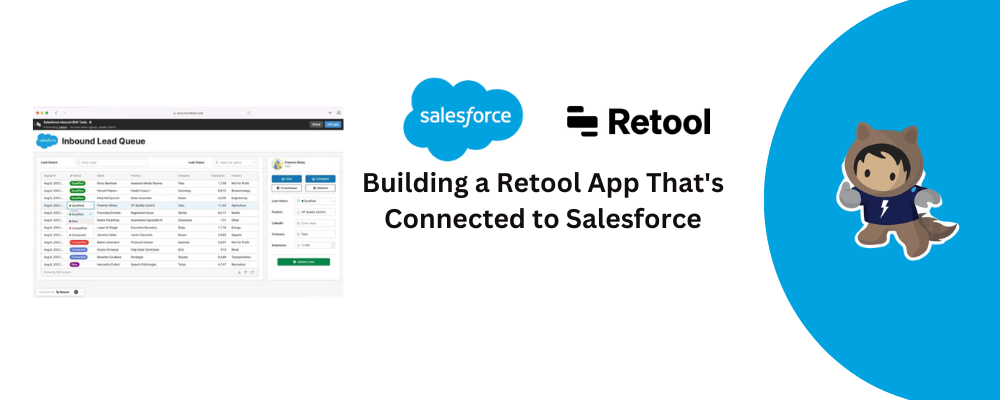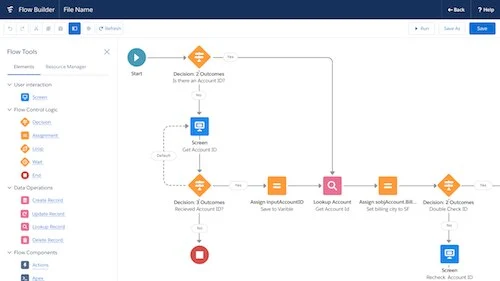Connecting applications to Salesforce can streamline your business processes and enhance productivity. Retool, a powerful tool for building internal applications, integrates seamlessly with Salesforce, offering an efficient way to manage and utilize your data. This article guides you through the steps of creating a Retool app that connects to Salesforce, from setup to deployment.
Check Out Retool: https://retool.com/
Table of Contents
- Introduction to Retool and Salesforce
- Why Integrate Retool with Salesforce?
- Prerequisites
- Setting Up Retool
- Connecting Retool to Salesforce
- Building Your First Retool App
- Designing the User Interface
- Implementing Business Logic
- Testing Your Retool App
- Deploying Your App
- Maintaining Your Retool App
- Common Issues and Troubleshooting
- Advanced Tips and Best Practices
- Case Study: Successful Integration
- Conclusion
Introduction to Retool and Salesforce
Retool is a versatile platform designed for building internal tools quickly and efficiently. It allows developers to connect various data sources, create custom workflows, and build intuitive user interfaces without extensive coding. Salesforce, a leading customer relationship management (CRM) platform, helps businesses manage their sales, marketing, and customer service operations. Integrating Retool with Salesforce combines the best of both worlds, enabling you to leverage Salesforce’s robust data handling with Retool’s flexible app-building capabilities.
Why Integrate Retool with Salesforce?
Integrating Retool with Salesforce offers numerous benefits:
- Enhanced Data Access: Retrieve and manipulate Salesforce data effortlessly.
- Streamlined Workflows: Create custom workflows tailored to your business needs.
- Improved Productivity: Reduce the time spent on repetitive tasks.
- Customizable Interfaces: Build user interfaces that fit your specific requirements.
Prerequisites
Before you begin, ensure you have the following:
- A Retool account.
- A Salesforce account with API access.
- Basic knowledge of API usage and app development.
Setting Up Retool
Creating a Retool Account
To start, visit the Retool website and sign up for an account. Follow the on-screen instructions to complete the registration process. Verify your email address to activate your account.
Navigating the Retool Interface
Once logged in, familiarize yourself with the Retool interface. The main components include:
- Home Dashboard: Your central hub for managing apps and data sources.
- Apps Section: Where you create and manage your Retool applications.
- Resource Management: Manage data sources and API integrations here.
- Settings: Customize your Retool environment.
Connecting Retool to Salesforce
Salesforce API Integration
To connect Retool with Salesforce, you’ll use the Salesforce API. Begin by logging into your Salesforce account and navigating to the “API” section under “Setup.” Here, you can generate the necessary credentials, such as the Client ID, Client Secret, and Access Token.
Configuring Salesforce Credentials
In Retool, go to the Resource Management section and select “Add Resource.” Choose Salesforce from the list of available integrations. Enter your Salesforce credentials (Client ID, Client Secret, and Access Token) and save the configuration. Test the connection to ensure it is working correctly.
Building Your First Retool App
Creating a New App
From the Retool dashboard, click on “Create New” to start a new application. Name your app and choose a blank template or a pre-built template that suits your needs.
Adding Salesforce Data
In your new app, add a Salesforce data source by selecting it from the resources you configured earlier. You can now query Salesforce data and bring it into your Retool app.
Designing the User Interface
Using Components
Retool offers a variety of components, such as tables, forms, and charts, to display your data. Drag and drop these components onto your app canvas to design your interface.
Customizing Layouts
Arrange the components to create a user-friendly layout. Use properties panels to customize the appearance and behavior of each component. You can adjust sizes, colors, and data bindings to suit your needs.
Implementing Business Logic
Writing Queries
Queries are essential for fetching and manipulating data. In Retool, you can write SQL queries, API requests, or JavaScript to interact with your Salesforce data. Test your queries to ensure they return the desired results.
Setting Up Triggers
Triggers automate actions based on specific conditions. For example, you can set up a trigger to update a Salesforce record when a user submits a form in your Retool app.
Testing Your Retool App
Before deploying your app, thoroughly test its functionality. Ensure all queries run correctly, components display data as expected, and user interactions work smoothly. Address any issues you encounter during testing.
Deploying Your App
Publishing Your App
Once your app is ready, publish it from the Retool dashboard. This makes the app accessible to your team members or other intended users. You can also create shareable links or embed the app in other platforms.
Managing User Access
Control who can access your app by setting user permissions. Retool allows you to define roles and restrict access based on user roles, ensuring sensitive data is protected.
Maintaining Your Retool App
Monitoring Performance
Regularly monitor your app’s performance to ensure it runs efficiently. Retool provides analytics and logging tools to help you track usage and identify potential bottlenecks.
Updating Features
As your business needs evolve, you may need to update your app. Use Retool’s intuitive interface to add new features, modify existing ones, and deploy updates without significant downtime.
Common Issues and Troubleshooting
Connection Problems
If you encounter connection issues between Retool and Salesforce, verify your API credentials and network settings. Ensure Salesforce API limits are not being exceeded.
Data Sync Issues
For data synchronization problems, check your queries and triggers. Ensure they are correctly configured and that data transformations are handled properly.
Advanced Tips and Best Practices
Optimizing Queries
To improve performance, optimize your queries by selecting only the necessary fields and using efficient filtering conditions. Avoid complex joins and heavy computations on the Salesforce side.
Enhancing Security
Security is paramount when dealing with sensitive data. Use OAuth for secure authentication, limit API token scopes, and regularly audit user access permissions to maintain a secure environment.
Case Study: Successful Integration
A medium-sized e-commerce company integrated Retool with Salesforce to streamline their order management process. By building a custom Retool app, they reduced manual data entry by 60% and improved order processing speed by 40%. This integration allowed their team to focus on more strategic tasks, leading to a significant boost in overall productivity.
Conclusion
Building a Retool app connected to Salesforce is a powerful way to leverage your CRM data in a customized, efficient manner. By following the steps outlined in this guide, you can create robust internal tools that enhance your business operations. Remember to optimize your queries, maintain security best practices, and regularly update your app to meet evolving needs.
FAQs
1. Can I connect multiple Salesforce accounts to a single Retool app?
Yes, Retool allows you to connect multiple Salesforce accounts to a single app by adding each account as a separate resource.
2. How secure is the Retool-Salesforce integration?
The integration is secure if you use OAuth for authentication, limit API scopes, and follow best practices for data security and access control.
3. Do I need to be a developer to use Retool?
While some technical
knowledge is beneficial, Retool is designed to be user-friendly, allowing non-developers to create apps with minimal coding.
4. Can I automate data updates in Retool?
Yes, you can set up triggers and scheduled queries in Retool to automate data updates and syncs with Salesforce.
5. What happens if my Salesforce API limits are exceeded?
If you exceed Salesforce API limits, your queries may fail. Monitor your usage and optimize your queries to stay within the limits.




